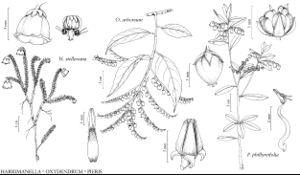Difference between revisions of "Pieris"
Edinburgh New Philos. J. 17: 159. 1834 ,.
FNA>Volume Importer |
imported>Volume Importer |
||
| Line 62: | Line 62: | ||
|publication year= | |publication year= | ||
|special status= | |special status= | ||
| − | |source xml=https:// | + | |source xml=https://bibilujan@bitbucket.org/aafc-mbb/fna-data-curation.git/src/bb6b7e3a7de7d3b7888a1ad48c7fd8f5c722d8d6/coarse_grained_fna_xml/V8/V8_971.xml |
|subfamily=Ericaceae subfam. Vaccinioideae | |subfamily=Ericaceae subfam. Vaccinioideae | ||
|genus=Pieris | |genus=Pieris | ||
Revision as of 00:17, 28 May 2020
Shrubs [trees] or vines. Stems ± erect; twigs multicellular stipitate-glandular-hairy and, sometimes, conspicuously strigose (hairs elongate, stiff, long-celled, eglandular), otherwise sparsely to densely unicellular-hairy. Leaves persistent or deciduous, alternate, sometimes pseudoverticillate [in whorls of 3]; blade ovate, elliptic, or slightly obovate, coriaceous, margins obscurely to clearly toothed or serrulate [entire], plane or revolute, surfaces multicellular, short-stalked stipitate-glandular-hairy (along with, in P. floribunda, stout, elongate hairs associated with marginal teeth, and unicellular-hairy on midvein adaxially); venation brochidodromous to reticulodromous (veins of varied thickness and conspicuousness). Inflorescences axillary or terminal panicles or racemes, 15–35-flowered, (borne the year preceding flowering). Pedicels: bracteoles 2, proximal or distal. Flowers: sepals 5, slightly connate, ovate [oblong-lanceolate]; petals 5, connate for nearly their entire lengths, white, corolla urceolate to cylindric-urceolate, lobes short; stamens 10, included; filaments straight or geniculate, glabrous or hairy, with 2 stout, minutely papillose spurs at anther-filament junction; anthers without awns, dehiscent by elliptic pores; pistil 5-carpellate; ovary 5-locular; stigma capitate. Fruits capsular, subglobose or globose to ovoid, (with unthickened sutures), dry. Seeds 40–100, ellipsoidal to obovoid, ± rectangular or angular-ovoid, or narrowly conic, flattened or not, (sometimes slightly winged); testa cells elongate or isodiametric. x = 12.
Distribution
se United States, West Indies (Cuba), e Asia.
Discussion
Ampelothamnus Small; Arcterica Coville; Portuna Nuttall
Species 7 (2 in the flora).
Selected References
Lower Taxa
Key
| 1 | Inflorescences axillary racemes; capsules with placentae central to nearly basal; styles strongly sunken into ovary apex; seeds with isodiametric testa cells; filaments geniculate, glabrous; twigs multicellular stipitate-glandular-hairy. | Pieris phillyreifolia |
| 1 | Inflorescences terminal panicles; capsules with placentae subapical; styles slightly sunken into ovary apex; seeds with elongated testa cells; filaments straight, hairy; twigs multicellular stipitate-glandular-hairy and conspicuously strigose (hairs stout, elongate). | Pieris floribunda |
